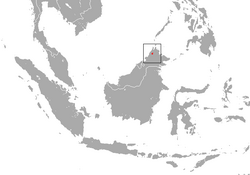Kinabalu shrew
Topic: Biology
 From HandWiki - Reading time: 2 min
From HandWiki - Reading time: 2 min
| Kinabalu shrew[1] | |
|---|---|
| Scientific classification | |
| Domain: | Eukaryota |
| Kingdom: | Animalia |
| Phylum: | Chordata |
| Class: | Mammalia |
| Order: | Eulipotyphla |
| Family: | Soricidae |
| Genus: | Crocidura |
| Species: | C. baluensis
|
| Binomial name | |
| Crocidura baluensis Thomas, 1898
| |

| |
| Kinabalu shrew range | |
The Kinabalu shrew (Crocidura baluensis) is a species in the family Soricidae.[1][2] It is endemic to the mountain Mount Kinabalu on Borneo, and its sister peak, Mount Tambuyukon.[3][4][5]
Despite its resemblance in external morphology with the mountain shrew C. lepidura (Sumatra), multilocus phylogenies reveal a recent divergence of C. baluensis from the Sabahan lineage of the Bornean shrew, C. foetida sensu lato. The latter inhabits the lower slopes in Kinabalu, up to around 1500 masl, where it is replaced by C. baluensis. The larger size and longer hair of C. baluensis respect to the lowland C. foetida sensu lato seems related to adaptation to the colder mountain conditions. Future sampling at mid-elevations in Kinabalu will be required to address whether this closely related lowland lineage represents a distinct species or if Crocidura baluensis should be redefined to include these lowland Sabahan populations[6]
Distribution and habitat
The Kinabalu shrew is native to Mount Kinabalu, where it inhabits montane rain forest (aka cloud forest) and higher-elevation subalpine shrublands and alpine meadows from 1,600 to 3,700 meters elevation. It is found in primary forests, degraded and secondary forests, and scrubland.[2]
It is also found in montane grasslands in the Kelabit Highlands above 1000 meters elevation.[2]
References
- ↑ 1.0 1.1 Wilson, D.E.; Reeder, D.M., eds (2005). Mammal Species of the World: A Taxonomic and Geographic Reference (3rd ed.). Johns Hopkins University Press. ISBN 978-0-8018-8221-0. OCLC 62265494. http://www.departments.bucknell.edu/biology/resources/msw3/browse.asp?id=13700034.
- ↑ 2.0 2.1 2.2 2.3 Clayton, E.; Kennerley, R. (2016). "Crocidura baluensis". IUCN Red List of Threatened Species 2016: e.T136726A22300422. doi:10.2305/IUCN.UK.2016-3.RLTS.T136726A22300422.en. https://www.iucnredlist.org/species/136726/22300422. Retrieved 11 November 2021.
- ↑ "Kinabalu Park.". http://www.sabah.edu.my/itma07040/life.htm.
- ↑ "Kinabalu National Park, Sabah, Borneo, Birds, Ecology, Mountain and Flower". http://www.endemicguides.com/KinabaluNP2.htm.
- ↑ Camacho-Sanchez M, Hawkins MTR*, Tuh Yit Yuh F, Maldonado JE, Leonard JA. 2019. Endemism and diversity of small mammals along two neighboring Bornean mountains. PeerJ 7:e7858 https://doi.org/10.7717/peerj.7858
- ↑ Arlo Hinckley, Miguel Camacho-Sanchez, Manuel Ruedi, Melissa T R Hawkins, Madeleine Mullon, Anna Cornellas, Fred Tuh Yit Yuh, Jennifer A Leonard, Evolutionary history of Sundaland shrews (Eulipotyphla: Soricidae: Crocidura) with a focus on Borneo, Zoological Journal of the Linnean Society, 2021, https://doi.org/10.1093/zoolinnean/zlab045
Wikidata ☰ Q1769440 entry
 |
 KSF
KSF
